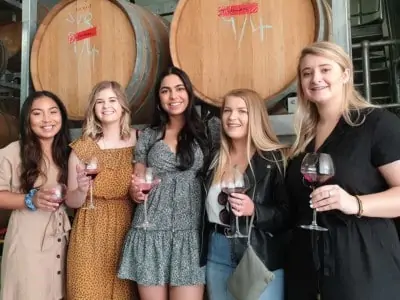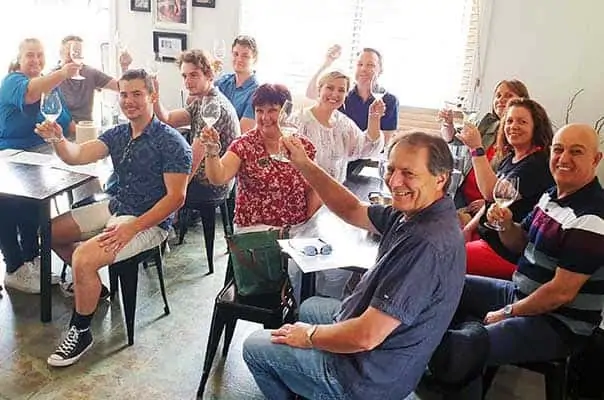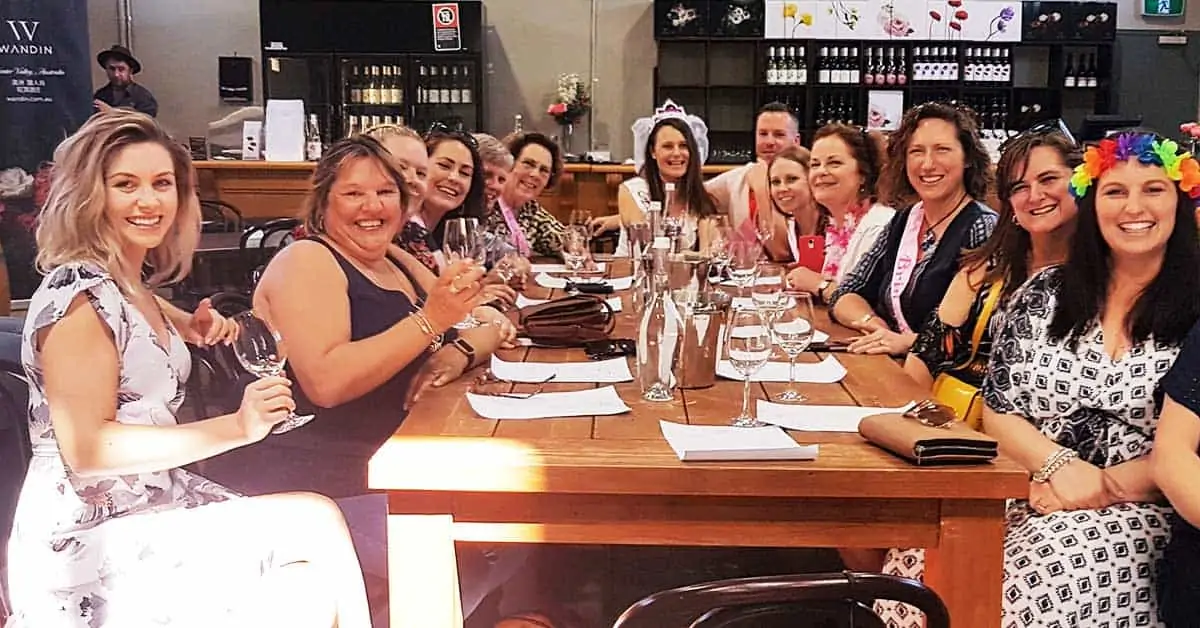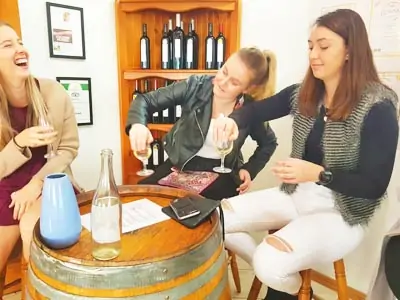
Looking to get the most from your tasting experience?
Insider tips to get the cellar doors to treat your group like royalty!
When you visit a Hunter Valley boutique winery you’re in for a real treat. We love to target small boutique cellar doors that are family owned or run by the winemaker with staff that are passionate about the region we call home and the outstanding wines produced here. A visit to the cellar door should be a fun and relaxing experience where you can learn a little more about wine but most importantly – be yourself!
That being said, while your guests are enjoying themselves and making judgements about the wine and the staff presenting it, the sommelier (a fancy word for a wine server/sales person) is making a judgement about the group as well. Not all groups receive the same tasting experience (even at the same venue) so knowing a few insider tips to “win over” your sommelier will take your wine experience to the next level. Every cellar door has a set tasting list and a “secret” list of “VIP or member’s only” wines. If you visit between June and Oct there are often new, “yet to be released” blends still in the tank that are about to be bottled that you could get a taste of, if you get on the good side of your sommelier!

I’ve seen groups that receive amazing tasting experiences that are allowed to try wines from the tank/barrel, premium vintage wines and even top shelf member’s only wines. If the cellar door has had a VIP member’s tasting group in earlier that day, they will have some of these “member’s only” wines open. The bottle can’t be resealed and isn’t fit for showing at the cellar door by the next day (the air will spoil the subtle flavours despite vacuum sealing and other fancy devices to slow the process) so they need to either take it home themselves to consume or give it out to their favourite group of the day. If you follow these tips and play your cards right, the lucky group could be you!
On the other hand, I’ve seen groups have their tasting experiences finished up early with smaller portions poured throughout. The reason? The vast majority of boutique Hunter Valley producers rely on direct sales from their cellar doors. Their output is too small for Dan Murphy’s or large bottleshop chains and while they may supply to a few small local restaurants, this isn’t enough to keep them in business. They need to make sales to survive so while the tasting experience is not a high pressure sales environment, they simply like to feel like the group appreciates their product, is interested in wine and they are in there with a chance to convince you to take home a little bottle of Hunter Valley goodness to say thank you for their time. When you think about it, you are talking about someone’s art and passion in bottle form!
Want to know what the cellar door staff are looking for in order to be treated like royalty? Want to know how to get more generous portions and perhaps access to wines off the normal tasting list? Follow these tips to take your tasting experience to the next level…..

(1) Never “shot” your tasting portion
What does slamming back your entire tasting portion in one mouthful tell your wine server? The secret body language here is that you didn’t enjoy the wine and you are slamming it down quick as you want the alcohol but not the taste. In fact you do miss out quite a bit when you do this as it does take at least 2 sips before you are ready to properly taste the wine on your 3rd sip. Your palate needs time to adjust as most wine tastings start with dry wines and end with sweeter wines. If you have just tasted a sweet wine at the last venue (or you still have remnants of your morning coffee or toothpaste in your mouth) then that first sip of dry white is going to taste particularly tart.
And try not to pull a face or openly comment “I don’t like this” or “that’s disgusting” (believe it or not, I’ve seen it happen!). You won’t like every wine you taste and it’s perfectly fine if your sommelier asks you what you thought of the wine they have just poured, to calmly say “I think that one was a bit too tart for me, can I try some sweeter wines?”. Your server will really appreciate your understanding that others may like that style (and love you for not rubbishing their product and passion) and will love that you’ve helped guide them in the right direction of what to pour for you next. Besides, you want to try wines you are likely to enjoy, right? And they want to show you wines you are likely to enjoy and maybe consider “adopting” a bottle of.
(2) Swirl, sniff then take 3 sips
Isn’t this just what “wine w#$nker’s” do? Actually they are doing it for a good reason. Aerating your wine (mixing your wine with air) will unlock the flavours and make it taste far better. And as mentioned above if you take 3 sips your palate will have time to adjust to the new flavour so you are truly tasting the wine on the 3rd sip.
Your sommelier will watch you do this and pick up that you know at least the basics of tasting wine. They just want to know that you appreciate their craft (or are open to appreciating it) and they will reward you with more generous tasting portions and tastings that go beyond the normal public tasting list.

(3) Ask questions
Cellar door staff love talking about their craft, their wine making processes, how they overcome the heat and sandy soil of the Hunter to produce great fruit (it’s not an ideal grape growing area as many people think) etc. so don’t be shy and ask lots of questions.
The majority of people we get on our tours are new to wine or “wine curious” but not connoisseurs so you are in good company and chances are there are others who would like to know the answer to your question as well. It makes for a super interesting wine experience and showing your sommelier that you are interested in their produce goes a long way to them showing you extra favour when it is time to pour the next portion!
Common Wine Tasting Questions
Yes. All wine tastings need to be booked now (updated as of 2023). Booking ahead became a common practice when Covid19 restrictions were in place and most cellar doors have kept up this practice so they can anticipate their staffing needs. Some cellar doors even require their tasting fees to be booked and pre-paid online. So to avoid disappointment, it is always best to book in advance even if you only have 2 people.
An average wine tasting is around 60mL and is generally enough for you to be able to take 3-4 sips of the wine. Remember you are not truly tasting a wine on the 1st and 2nd sips as these just enable your palate to adjust to the acids and tannins and for your mouth to be coated in the new beverage (you’ve probably tasted a few wines in the previous few minutes if you are doing a standard 6 – 8 wine tasting in a 30-40 minute cellar door session.
So the 3rd – 4th sip is when you’re actually tasting the wine and this is taken into account when the portion is poured. Your sommelier is also taking into account the NSW RSA (Responsible Service of Alcohol) laws and restricting each pour to around 60 – 90mL in order to keep patrons within these reasonable limits.
That being said, all portions are poured “by eye” and while your friendly cellar door staff are used to pouring their wines fairly consistently into the size glasses they are used to at their cellar, they are not using any measuring equipment so the exact amount poured can be quite variable. The moral of the story here is to leave the car keys at your accommodation and play it safe with a tour guide to do the driving for you.
No and in the age of covid19 (2023 and beyond) the act of “spitting” is definitely a “no no”. While this may have been acceptable in the past, most cellars in the Hunter will ask you to leave if you do this due to the unsanitary nature of this practice in the new Covid Safe world that we live in.
Do you have to endure drinking all of a tasting portion if you don’t like the wine? Absolutely not and it is quite acceptable to tip the remaining portion of the wine in your tasting glass into the spittoon (this is it’s modern purpose in 2023), just don’t “spit” into it.
Other people may feel that they have “had enough” and wish to slow down their alcohol consumption and just taste the first 1-2 sips and discard the rest.
Whatever your reasons are, it is a personal choice as to whether you consume all of your tasting portion or you choose to tip some of it into the spittoon. Generally we’ve noticed most people consume their tasting entirely (you’re here to enjoy yourself, right?) however there is no pressure either way.
The most common way to cleanse your palate is to take 1-2 sips of water (and swallow them) every 3 wine tasting portions. Don’t take a sip of water after every tasting otherwise you will “saturate” your palette.
Generally wines are grouped together into sparkling’s, whites, reds and dessert wines and it is a good idea to take 2 sips of water as you move between groups. For example you may have tasted 3 white wines and your sommelier may then instruct the group to pour some water into your glass as the red wines are next. Your friendly cellar door presenter will usually guide you through the process in this way so you get the most out of your tasting and you know what to expect.
Occasionally a sparkling wine or a sorbet (in the case of a premium tasting) or a portion of food (eg. cheese to coat the palette with natural fats to cushion the bitterness of the tannins in a full bodied red wine) may be used as a palate cleanser when moving between varietal groups as above however this is less common.
No you don’t have to tip your server at a wine tasting in Australia. Tipping in Australia is not required generally and quite a rare practice at most hospitality venues. Of course you are welcome to tip your server if you’ve had an outstanding experience if you wish.
Almost all cellar doors charge a wine tasting fee (unless you are a wine club member of a particular cellar door and it could be argued that you have paid for your tasting in your membership anyway) so this is covered in the tasting fee.
That being said, most cellar door tasting fees only cover the costs of the wine poured and the sommelier’s time so it is regarded as a little rude to not purchase at least one bottle of your favourite wine after a wine tasting session. It is an unsaid expectation to make a purchase as the purpose of your visit to the cellar door.
It depends on the size of the group. Generally a standard wine tasting for a group of 12 people will last around 40 minutes and 6-8 tasting portions are poured. If you have a larger group of up to 20 people then a wine tasting can last up to 50-60 minutes as it takes extra time to serve everyone and some sommeliers will wait before moving on to the next wine if people from the group visit the bathroom during the tasting (they don’t want anyone to miss out on their commentary about each wine as you are less likely to purchase a bottle if you know nothing about the wine portion sitting in front of you as you missed the explanation whilst in the bathroom).
If you are only visiting as a couple or small group (eg. 4-6 people) then the tasting may only take 20-30 minutes as such small groups usually receive a custom tasting (ie. they ask what wines you are interested in tasting rather than following a standard “set list” for a group).
Wine tastings for wine club members or special “reserve” tastings can take even longer (90 minutes to 2 hours) with up to 12 wines poured. Some tastings will serve grazing platters consisting of cheeses, deli meats (eg. prosciutto ham), crackers, olives, fruit pastes and any specialty local produce that particular cellar door is known for. Of course these tastings usually come with much higher tasting fees (these can apply even for wine club members due to the food component) of up to $40-60 per person.
Why so high? Other than the obvious food costs involved, bottles of reserve, single vineyard or premium quality wines are not opened for tasting purposes as often and as the finer quality flavours of a wine disappear within the first 24 hours after opening, these wines can’t be used for another tasting on a different day. It’s a case of “the whole bottle or nothing” with such tastings so essentially your group is paying for the bottle across the group in the tasting fee.
A cellar door will usually only host a member’s or premium tasting earlier in the day so they can offer the left over portion in the bottle to other guests later in the day on the off-chance that they may be willing to purchase a premium wine. The cellar door staff only have to discard the bottle at the end of the day anyway (such a crime!) so if you are lucky enough to win the favour of your sommelier (using our suggestions above) then you may be offered the chance to try one of these premium vintages if they happen to have bottles open from a previous member’s only tasting!
12 hours is the standard length of time a still wine (no bubbles) can be served at a cellar door once opened. Usually if a wine is not used that same day it is discarded. The wine itself is still fine to drink for up to 3 days (if refrigerated) however the majority of the finer qualities of the flavours are usually gone 12 hours after opening due to exposure to the air and are completely gone at the 24 hour mark. So at that point you are just tasting alcohol essentially.
As for wine drinking at home, most wines will still be acceptable the day after opening but by day 3, you will notice a slightly vinegar-like, acidity taking hold in the bottle so generally it is best to consume a wine within the first 48 hours.
Devices such as a “vinus” can be placed over the neck of the bottle instead of the screw cap and “pumped” to draw air out of the bottle and prevent air from getting in. These devices slow the process down and often you will see such devices placed over bottles at the cellar door even though they have only just been opened but in my personal experience, once a wine bottle is opened you are fighting a losing battle against the air. So it is best to only open a high quality bottle of wine when you have the time to drink most of it (if not all of it!) or open it when you have some friends to help you finish the bottle whilst at it’s peak.
It is best to eat something bland (eg. plain toast, water crackers or cereal with unflavoured milk). You want to avoid spicy, highly acidic, bitter or super sweet foods or beverages. For example drinking sweet coffee before your tasting will make all the wines taste like metal! And please don’t smoke prior to a wine tasting (if you can help it) as smoking is the quickest way to kill your ability to taste subtle flavours!
It is also best to time it right and eat and drink something bland around 1-2 hours before your tasting. Only eat as much as you need to “line your stomach” but not leave you feeling full as your taste buds will be enthusiastic if you are still anticipating food.
It might not sound exciting but a small cup of plain tea with milk (leave out the sugar) and 1 piece of toast with a slight smear of butter and vegemite is my personal favourite to consume before a wine tasting. All of these are bland enough to not ruin your palate but that slight vegemite flavour is enough to ignite your sense of hunger and palate curiosity.
Keep in mind that any foods that are high in fat or protein content such as cheeses will mask the bitter flavours of the tannins in red wines. I personally prefer my red wines smoother and with less tannin so I would consume cheese if I knew that I would be tasting full bodied red wines however I know that I am not truly tasting the red wine in this instance.
More of a beer drinker?
Is all this wine talk a bit much for you? You don’t have to suffer through a “wine only” tour. There are lots of options for incorporating craft beers or cider into your tour. Check out our wine and beer tours advice for suggestions as to how we can do this on a tour for you.
While Hunter Valley wine tasting tours are not high pressure sales affairs by any means, the cellar door staff just wish to communicate their message and have you genuinely consider their craft and if you send the message that you are willing to do so, they will be far more generous with what they are willing to show you and how much time they spend with our group. And believe me – it is well worth it!
Now that you’re ready to get the most from the many tasting experiences that the Hunter Valley has to offer, let us worry about the driving! Check out our wine tours of the Hunter Valley with pickups from local accommodation venues in Pokolbin, Lovedale, Rothbury, Cessnock, Broke, Maitland, Singleton and more!
